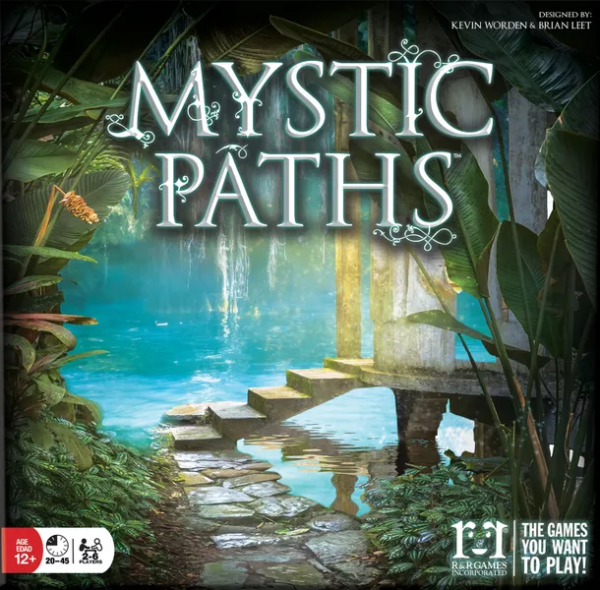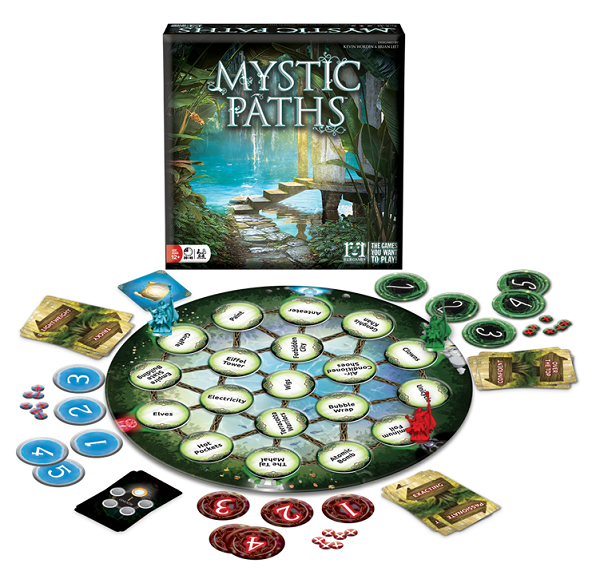Dive Into Magical Cooperative Clue Giving in Mystic Paths

Use clues to help the other players discern your path from word to word around the board, before swapping roles and trying to deduce their own way!
Published by R&R Games, Mystic Paths is a cooperative party clue-giving game for 2-6 players that plays in 20-45 minutes.
Gameplay
The board consists of a series of interconnected spaces. You place tiles in each of these spaces. Each of these tiles lists a person, place, or thing. Pathways between the spaces show which ones are connected to each other.
Each player selects a player token and places it at one of the starting locations around the board. You then take four clue cards into hand and one map card. The map card shows the path you must take across the board, and which tiles you must move through. You will never move backwards onto a tile you just left, but some maps will have you moving onto the same tile more than once.
Every round, each player will attempt to move three spaces along their path. You select three clue cards and place them face-up on the table, using number tokens to indicate which card goes with the first tile you want to move onto, which goes with the second, and which goes with the third. Each clue card has two words on it, so you also indicate which of the two words is your clue, using the number tokens to cover up the second word. You can also place a ‘not’ token on a clue word to indicate that your clue is the opposite of that word.
Once everyone has played their three clues, you take turns guessing each player’s path. You start with the first clue, looking at which tiles the player's piece could move to from his present location. You are also encouraged to look ahead at the player's other clues and the nearby tiles they might be referring to for the second or third move.
When you believe you have guessed the first tile, you touch it. If you are wrong, that player's turn is immediately over. You place a ‘not’ token on the incorrect tile to remember for next time and move on to guessing the next person’s tiles. If you are correct, you move that player’s token onto the new tile, leaving the token’s base behind to indicate where it was moved from (since you never move backward onto a tile you just left) and begin to work on the second clue, and then the third.
You continue until each player has had their cards guessed. Any clues that were not correctly guessed remain on the table so that the other players can remember past, unguessed, clues when they are guessing during the next round.
At the end of the round, everyone draws back up to four clue cards, and then you are ready for the next round. During the fifth round, players can play four clue cards, for a total of four spaces they want to move on their path.
If you reach the end of your path before the game ends, you win a silver cup tile if it is round five, which adds one point to your score, and a gold cup if it is round four, which is worth two. The game ends after the fifth round, and everyone earns points equal to how many spaces along their paths they went. You add up all the player points, divide that by the number of players, and then compare the final number to the chart in the rulebook to see how well you did as a team.

Review
Mystic Paths is a very creative twist on a popular type of party game. There are elements of a lot of word and clue-giving games here, but they come together in a really nice package, with some clever twists and a theme that sets it apart. These types of games aren’t typically quite so thematic, and it’s refreshing to find one that is.
There’s a great range of words across the tiles, and the clue cards also come in a big range, especially when you consider that you can also use your ‘not’ tokens. Having two clues per card to choose from was a nice touch as it gives you options…but not too many. Trying to work with the hand you’ve been dealt is quite fun and is also where the heart of the game lies.
Every now and then your clue cards will line up perfectly with the tiles you need to reach, but more often than not you have to make a stretch or get creative. At times like these, it's key for players to look ahead and try to deduce what the future clues might be referring to, and all of this can lead to all the fun discussions that make these types of games so enjoyable to play as a group.
The components are generally pretty nice, with the board looking great and making it easy to read which spaces are connected. Our game was missing one base for one of the player tokens, but it's not essential to the game as it’s not too difficult to remember what tile someone just came from. You can have the player check his map card to confirm if necessary. However, the bases were a little annoying to play with anyway, and a smoother option, such as a simple token, seems like it would have worked just as well. In general, the player pieces, while nice to look at, are too large and do tend to block some of the letters on the tiles.
Mystic Paths is pretty straightforward to teach and learn. The game length does increase with more players, and a six-player game is probably going to feel pretty long. However, since you're working with the clues that are in your hand, and all players are selecting their clues at the same time, there’s not as much downtime as you come up with clues as there is in similar games. It is also fun that everyone gets to give clues and guess during each round. The theme makes the game extra special, resulting in a very solid party game that’s a lot of fun.
Pros: Thematic, fun clue system, a lot less downtime than you often find in clue games
Cons: Player pieces are too large, the bases are not as smooth to play with as they could be, we were missing one base in our copy, game length will run long at a full player count
Disclosure: we received a complimentary review copy of this game.







